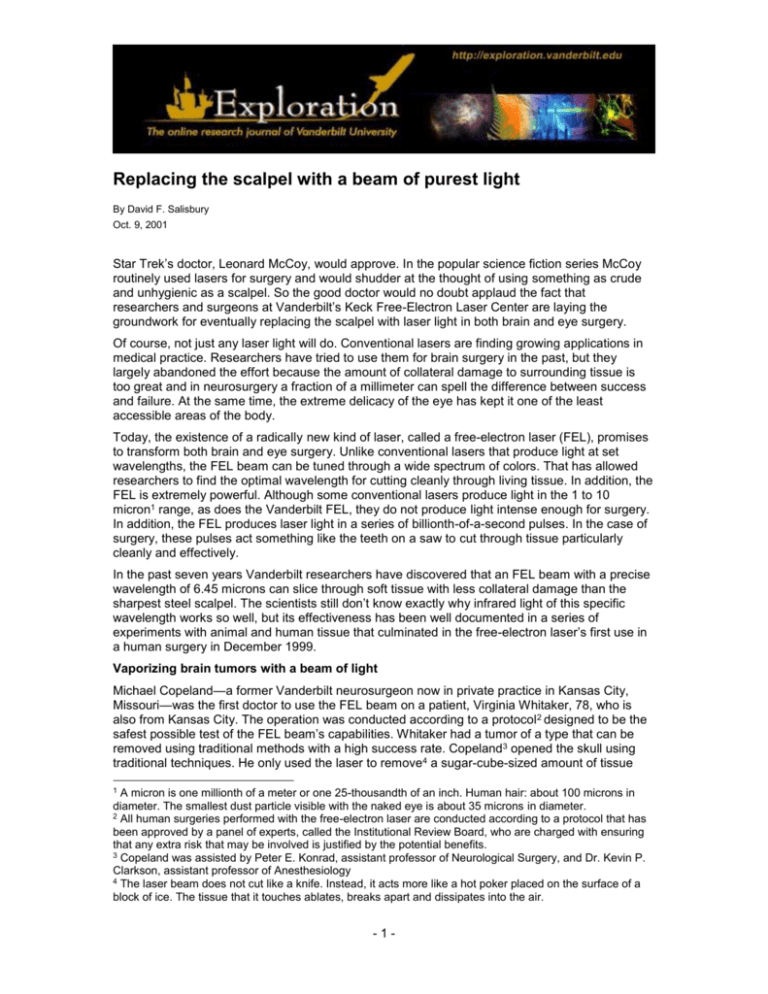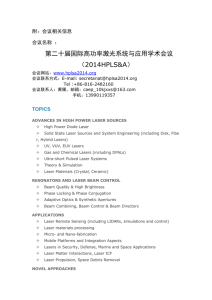Replacing the scalpel with a beam of purest light
advertisement

Replacing the scalpel with a beam of purest light By David F. Salisbury Oct. 9, 2001 Star Trek’s doctor, Leonard McCoy, would approve. In the popular science fiction series McCoy routinely used lasers for surgery and would shudder at the thought of using something as crude and unhygienic as a scalpel. So the good doctor would no doubt applaud the fact that researchers and surgeons at Vanderbilt’s Keck Free-Electron Laser Center are laying the groundwork for eventually replacing the scalpel with laser light in both brain and eye surgery. Of course, not just any laser light will do. Conventional lasers are finding growing applications in medical practice. Researchers have tried to use them for brain surgery in the past, but they largely abandoned the effort because the amount of collateral damage to surrounding tissue is too great and in neurosurgery a fraction of a millimeter can spell the difference between success and failure. At the same time, the extreme delicacy of the eye has kept it one of the least accessible areas of the body. Today, the existence of a radically new kind of laser, called a free-electron laser (FEL), promises to transform both brain and eye surgery. Unlike conventional lasers that produce light at set wavelengths, the FEL beam can be tuned through a wide spectrum of colors. That has allowed researchers to find the optimal wavelength for cutting cleanly through living tissue. In addition, the FEL is extremely powerful. Although some conventional lasers produce light in the 1 to 10 micron1 range, as does the Vanderbilt FEL, they do not produce light intense enough for surgery. In addition, the FEL produces laser light in a series of billionth-of-a-second pulses. In the case of surgery, these pulses act something like the teeth on a saw to cut through tissue particularly cleanly and effectively. In the past seven years Vanderbilt researchers have discovered that an FEL beam with a precise wavelength of 6.45 microns can slice through soft tissue with less collateral damage than the sharpest steel scalpel. The scientists still don’t know exactly why infrared light of this specific wavelength works so well, but its effectiveness has been well documented in a series of experiments with animal and human tissue that culminated in the free-electron laser’s first use in a human surgery in December 1999. Vaporizing brain tumors with a beam of light Michael Copeland—a former Vanderbilt neurosurgeon now in private practice in Kansas City, Missouri—was the first doctor to use the FEL beam on a patient, Virginia Whitaker, 78, who is also from Kansas City. The operation was conducted according to a protocol 2 designed to be the safest possible test of the FEL beam’s capabilities. Whitaker had a tumor of a type that can be removed using traditional methods with a high success rate. Copeland3 opened the skull using traditional techniques. He only used the laser to remove4 a sugar-cube-sized amount of tissue 1 A micron is one millionth of a meter or one 25-thousandth of an inch. Human hair: about 100 microns in diameter. The smallest dust particle visible with the naked eye is about 35 microns in diameter. 2 All human surgeries performed with the free-electron laser are conducted according to a protocol that has been approved by a panel of experts, called the Institutional Review Board, who are charged with ensuring that any extra risk that may be involved is justified by the potential benefits. 3 Copeland was assisted by Peter E. Konrad, assistant professor of Neurological Surgery, and Dr. Kevin P. Clarkson, assistant professor of Anesthesiology 4 The laser beam does not cut like a knife. Instead, it acts more like a hot poker placed on the surface of a block of ice. The tissue that it touches ablates, breaks apart and dissipates into the air. -1- Replacing the scalpel with a beam of purest light from the center of the tumor mass. The rest of the golf-ball-sized tumor was removed using conventional methods. Examination of the tumor showed that the laser beam removed tissue with only one to three cell layers of collateral damage. Initial efforts to use the FEL beam as a surgical scalpel centered on a shorter wavelength near 3 microns, but they failed. The researchers picked 3 microns because it was one that is absorbed readily by water molecules, but they discovered that it worked too well, creating microscopic steam explosions and excessive heat that damaged surrounding tissue. In 1993 Vanderbilt biophysicist Glenn Edwards5 got the idea of trying wavelengths around 6.4 microns, a wavelength absorbed both by water and many protein molecules. A number of his colleagues didn’t think the idea had much merit, but Edwards persisted. "It seemed more relevant to focus on the absorption of laser light by the proteins in soft tissue rather than water," he said. After making some basic measurements and doing some back-of-the-envelope calculations, Edwards and Vanderbilt ophthalmologist Regan Logan tried the beam on some corneal tissue. It drilled a perfect hole. “We looked at it in disbelief. I had never before had an experiment work the first time," he said. Edwards and Logan invited a number of other scientists to test the technique, including Michael Copeland. They conducted a number of experiments on a variety of tissues and found that wavelengths near 6.45 microns were optimal for cutting all soft tissues. 6 Since then other researchers have found two wavelengths—7.5 and 7.7 microns—that cut through bone particularly cleanly. Copeland led a research effort that confirmed that 6.45 microns worked just as well with brain tissue as it does with other kinds of soft tissue. His goal is to use the laser beam to vaporize brain tumors completely while minimizing the damage to healthy brain tissue. In the operation on Mrs. Whitaker and two follow-up operations over the following year and a half, he found that the laser beam worked “beautifully, just the way that we expected.” In the future, neurosurgeons working with the laser hope to use it with a computer-assisted guidance system that will allow them to safely remove small brain tumors near vital nerves and arteries that are too risky to cut out with conventional techniques. Probing the hidden area behind the eye Shortly after the second brain surgery, another team of surgeons began testing the FEL beam’s usefulness for eye surgery. Here the issues are slightly different. The extreme delicacy of the eye makes the area behind it one of the most difficult parts of the body to treat. “It is one place we haven’t visited yet,” says Denis O’Day7, who was involved in early studies that applied the FEL to ophthalmology, “and this approach has the potential to take us there.” Because of the experimental nature of the procedure, the initial eye surgery on a human was performed on a patient8 with end-stage traumatic glaucoma who was having the eye removed. The operation was performed by Assistant Professors of Ophthalmology Karen Joos and Louise Mawn. First, the surgeons rotated the eye in the socket to expose the optic nerve using the wellestablished procedure of detaching a muscle on one side of the eye. 9 Second, they cut a tiny flap in the optic nerve sheath using the laser beam. Finally, they removed the entire eye. Normally, cutting the optic nerve sheath is used to treat a condition called pseudotumor cerebri, a relatively common neurological illness among young, obese women. A build-up of cerebral-spinal fluid in the optic nerve causes blurred vision, headaches and even loss of vision. Because pseudotumor cerebri occurs eight times more frequently in young women than in young men, He left Vanderbilt to become the director of Duke’s FEL program. The research was published in the journal Nature [Vol. 371; 29Sept1994]. 7 The George Weeks Hale Professor and chair of ophthalmology. 8 The patient preferred to remain anonymous. 9 Currently, the only alternative is to cut an opening in the facial bones surrounding the eye, which causes permanent scarring or disfigurement. 5 6 -2- Replacing the scalpel with a beam of purest light scientists suspect that hormones play a role, but little is known about its cause. Surgery is called for when the condition does not respond to dietetic and medical treatment. Cutting a small opening in the sheath surrounding the optic nerve relieves the pressure build-up, preventing further vision loss and, in some cases, even restoring lost vision. “I’m a traditional surgeon, so I was very skeptical when I was first confronted with the idea of using a laser for this kind of an operation,” admits Mawn. “After trying it out several times on animals, however, I became convinced that this is a better, safer and more efficient approach.” Mawn is particularly impressed by the fact that the laser beam can be focused to a much smaller size than a scalpel or scissors, allowing it to be handled more precisely. In the case of the operation on the optic nerve sheath, the FEL has an additional advantage: a microscopic layer of fluid between the nerve and sheath dissipates the heat of the laser and so provides an extra layer of protection for the delicate nerve fibers. The operation was performed with a special, curved probe that was designed by research assistant professor Jin H. Shen. The procedure was based on several years of basic scientific research. As part of this effort, Joos worked closely with Vivien Casagrande, professor of cell biology, psychology and ophthalmology. They compared the cutting characteristics of the FEL beam with those of conventional surgical methods on a number of different animal species. The studies included a detailed analysis of the biological response of the nerve cells to these injuries and their effects on visual function. This preliminary research has now been confirmed by six operations following the same basic protocol. The process of rotating the eye in the socket is technically difficult and carries a high degree of risk. The eye surgeons think that they can avoid these complications by combining the FEL probe with an endoscope, a slender optical instrument that allows the user to see parts of the body that are ordinarily hidden from view. According to Joos, they have developed such a combined probe, which is only 1.5 millimeters10 thick, and have been using it in animals to evaluate its effectiveness for treating conditions like congenital glaucoma. In a paper published in the Journal of Glaucoma, for example, they report using this method to treat congenital glaucoma. The combination endoscope/laser allowed them to locate and cut open the eye’s natural drainage areas located around the outside rim of the iris even when they were hidden beneath an opaque cornea. An effort to develop an orbital endoscope was made in the 1970s, but was abandoned because there was no way to control bleeding if it started behind the eye, the researchers say. Combining the instrument with an FEL beam, however, could overcome this obstacle. For one thing, the laser beam does not appear to cause as much bleeding as mechanical cutting. Also, its smaller size and precise handling allows surgeons to avoid disrupting even very small blood vessels. “The surprising thing about these operations,” summarizes center director David Piston 11, “is that there have been absolutely no surprises. The laser beam has performed exactly as predicted.” Because of their size, cost and complexity, no one expects free-electron lasers to begin showing up in hospitals in the foreseeable future. But once researchers have identified the specific characteristics that make the FEL so effective at cutting tissue and bone, it should be possible to design special purpose lasers that replicate these characteristics. These devices would be much smaller, simpler and less expensive and so could ultimately replace the steel scalpel with beams of pure light. - VU - 10 One twentieth of an inch. Associate professor of molecular physiology and biophysics; associate professor of physics, investigator and fellow of the John F. Kennedy Center 11 -3-







